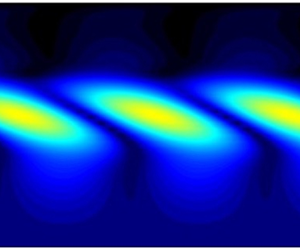Article contents
A new linearly unstable mode in the core-annular flow of two immiscible fluids
Published online by Cambridge University Press: 06 May 2021
Abstract

The linear stability characteristics of pressure-driven core-annular pipe flow of two immiscible fluids are considered to investigate the effects of the density and viscosity ratios, the Reynolds number, the interface location and the interfacial tension. Both liquid–liquid and gas–liquid systems are examined. A new type of interfacial mode associated with the axisymmetric and corkscrew perturbations is discovered for certain ranges of the viscosity and density ratios in the immiscible liquid–liquid system. Two distinct unstable regions at long and short wavelengths are observed. The long-wavelength unstable region forms a close loop, indicating that it is not a Tollmien–Schlichting mode. The new interfacial mode observed in the present study is similar to that discovered by Mohammadi & Smits (J. Fluid Mech., vol. 826, 2017, pp. 128–157) in two-layer Couette flow for low viscosity ratios. In contrast to the two distinct unstable regions found in the immiscible configuration, the corresponding miscible system contains only one unstable mode. It is found that, in the liquid–liquid systems, the corkscrew (axisymmetric) perturbation is dominant when the annular fluid is less (more) viscous than the core fluid. On the other hand, the axisymmetric perturbation is always the dominant one in the gas–liquid system. In gas–liquid systems, the interfacial tension stabilises the short-wave and destabilises the long-wave perturbations, while increasing the interface radius stabilises the flow due to the presence of a plug region in the pipe.
- Type
- JFM Papers
- Information
- Copyright
- © The Author(s), 2021. Published by Cambridge University Press
References
REFERENCES
- 7
- Cited by





